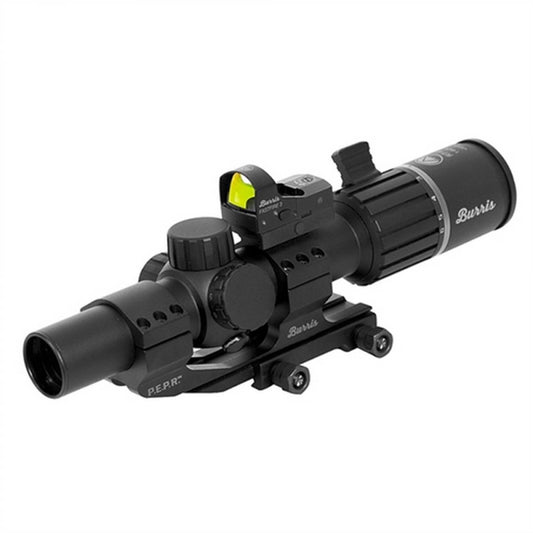

Burris RT-6 Rifle Scope Combo with FastFire III and PEPR Mount offers a 1-6x magnification range, making it a versatile choice for tactical shooting and 3-Gun competitions. The true 1x setting allows for both eyes open engagement, enhancing speed and accuracy during target acquisition. With an illuminated ballistic AR reticle, this scope provides clear visibility in various lighting conditions, ensuring you can make precise shots at both short and long ranges. The durable construction and forgiving eye box make it ideal for quick handling and competitive shooting.
Lightweight and compact, the RT-6 features built-in throw levers for swift magnification adjustments. Its ballistic reticle incorporates trajectory compensation out to 600 yards, making it suitable for .223 and 5.56 ammunition. This tactical scope kit is designed to enhance your shooting performance while ensuring reliability and ease of use, whether you're a beginner or an experienced shooter.
Features:
- FORGIVING EYE BOX for quick target acquisition, allowing faster engagement.
- TRUE 1X MAGNIFICATION for both eyes open shooting, enhancing situational awareness.
- ILLUMINATED RETICLE improves visibility in low light conditions, ensuring clarity at all times.
- ROTARY DIAL ILLUMINATION control with battery saver stops for efficient power management.
- COMPACT DESIGN facilitates easy handling and lightweight portability during competitions.
- VERSATILE TACTICAL RETICLE with milradian measurements for precise long-range shooting.
- SHOCKPROOF CONSTRUCTION for reliable performance in rugged environments.
- INCLUDED PEPR MOUNT allows for easy attachment to various firearms, enhancing versatility.
Technical Specifications
| Specification | Details |
|---|---|
| Magnification | 1-6x |
| Objective Lens Diameter | 24mm |
| Tube Diameter | 30mm |
| Length | 10.5 inches |
| Weight | 16 oz |
| Reticle | Illuminated Ballistic AR |
| Waterproof | Yes |
| Fog-proof | Nitrogen purged |
What's in the Box?
- Burris RT-6 Rifle Scope
- FastFire III Red Dot Sight
- PEPR Mount
- Lens covers
- User manual
Customer Reviews
"This scope has completely changed my shooting experience. Fast target acquisition is a game-changer!"
"The illuminated reticle is perfect for low-light conditions. Highly recommend for competitive shooting!"
"Easy to use, and the throw lever makes adjustments quick. Excellent value for the price!"
FAQ
How does the RT-6 perform in low light conditions? The illuminated reticle enhances visibility, making it suitable for shooting at dawn or dusk. Users have reported excellent performance even in challenging lighting.
Can the scope be used for both short-range and long-range shooting? Yes, the RT-6's versatile reticle allows for accurate shooting out to 600 yards, while its true 1x magnification is ideal for close-range targets.
Is the scope durable enough for rugged use? Built with shockproof construction and nitrogen purged for fog resistance, it's designed to withstand tough conditions, making it reliable for tactical applications.
Similar Models
Looking for more options? Explore the complete range of Burris optics, including the Burris XTR II 1-8x24mm for extended range capabilities and the Burris Fullfield TAC 4.5-14x42mm for precision shooting. Find the perfect scope to match your shooting style and preferences.
You May Also Like
Here’s some of our most similar products people are buying. Click to discover trending style.






